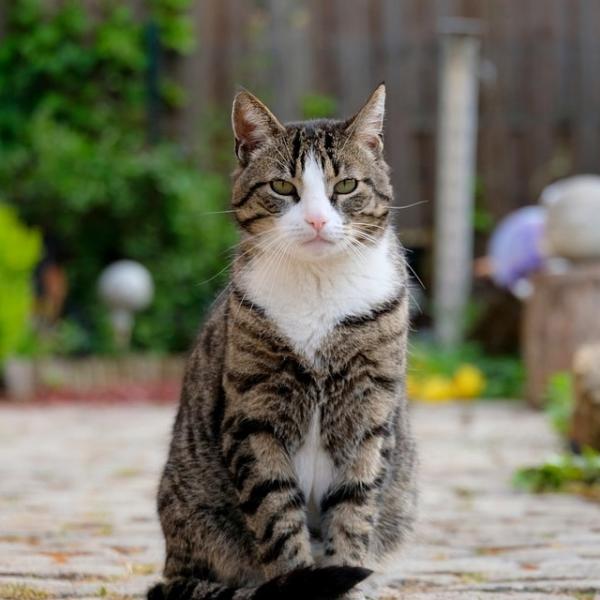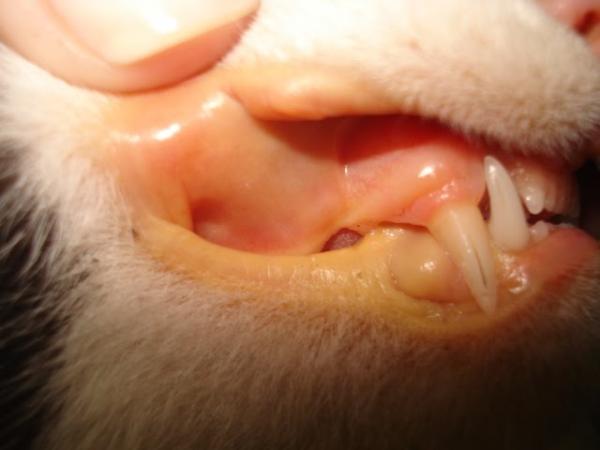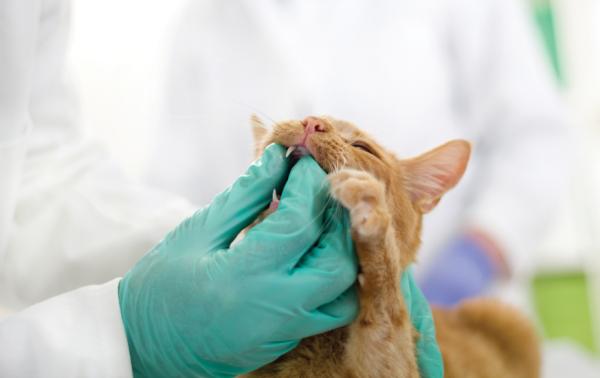Jaundice in cats – Causes and symptoms

La jaundice it is defined as the yellowing pigmentation of the skin, urine, serum and organs by accumulation of pigment called bilirubin in the blood or tissues. It is a symptom, with what is common in multiple diseases, so if our cat shows an abnormal color at some point in your body, our veterinarian will have to perform several tests to establish a differential diagnosis.
If your cat suffers from this alteration and you want to know a little more about its origin, in the following article we detail them Causes of jaundice in more common cats.
What is bilirubin?
Bilirubin is a product that is formed after degrading the erythrocytes (red blood cells), when they reach the end of their life (which lasts about 100 days). In the spleen and bone marrow, these red blood cells are destroyed, and from the pigment that gave them their color, hemoglobin, another yellow color is formed, bilirubin.
It is a complex process in which hemoglobin first passes to be transformed into biliverdin, which in turn is transformed into biluriblack soluble in fat, and is released into the circulation, through which it travels bound to a protein until it reaches the liver.
In the liver, the great purifier of the organism, it is transformed into conjugated bilirubin and se stores in the gallbladder. Each time the vesicle empties into the small intestine, a portion of bilirubin leaves with the rest of the components of the bile and, after the action of certain bacteria, it finally transforms into the normal pigments that we see daily, although not we know: the estercobilina (gives color to the feces) and the urobilinogeno (it gives color to the urine).
Why does jaundice appear in cats?
At this point we can already see that the liver It’s the key. Jaundice appears when the body is unable to properly excrete bilirubin and other biliary components, although the place where the failure occurs, is difficult to find in the first instance.
To simplify this complex issue, we could talk about:
- Hepatic jaundice (when the cause is in the liver).
- Posthepatic jaundice (The liver does its job, but in storage and transport there is a failure).
- Non-hepatic jaundice (when the problem has nothing to do with the liver, or with the storage and excretion of the pigment)
Symptoms of jaundice in cats
As indicated at the beginning of the article, jaundice itself is already a symptom that indicates that the cat suffers from a health problem. Likewise, the most obvious sign of this disorder is the yellowish color of the skin, being most evident in the mouth, ears and, in general, areas with less fur of the feline.

Hepatic jaundice
In hepatic jaundice we observed that something fails at the level of the liver, since it can not fulfill its mission and is not able to output the bilirubin what comes to him Under normal conditions, liver cells (hepatocytes) excrete this pigment into the bile canaliculi that run through the cellular network, and from there to the gallbladder. But when the cells are affected by some pathology, or there is an inflammation such that it is not possible to pass the bilirubin to the bile duct network, a intrahepatic cholestasis.
What causes can cause jaundice in cats?
Any pathology that directly affects the liver can produce this bilirubin accumulation. In cats we have the following:
- Hepatic lipidosisThe feline fatty liver may appear as a consequence of prolonged fasting in cats with a lot of fat, which moves without order to the liver in an attempt to get nutrients and eventually invades it, as well as for many other reasons. But sometimes you never know what your appearance is due to, and we should call it idiopathic hepatic lipidosis.
- Neoplasia: especially in elderly patients, primary neoplasms are a frequent cause of liver failure. They are called primaries because they originate in the liver, without external factors, unlike secondary.
- Feline hepatitis: hepatocytes can be destroyed by substances that the cat accidentally ingests, and that can lead to hepatitis.
- Biliary cirrhosis: Fibrosis of the bile canaliculi causes an inability to fulfill its mission and evacuate bilirubin to the gallbladder.
- Alterations at the vascular level of birth.
Sometimes we have alterations that can cause secondary hepatic failure, that is, produced by pathologies that, as a side effect, give rise to problems in the liver. We can find livers affected by Neoplasms secondary to feline leukemia and also alterations or hepatic damage due to infection of feline infectious peritonitis, toxoplasmosis, or due to diabetes mellitus. As a consequence of any of these problems, we will see a clear jaundice in the cat.
Posthepatic jaundice
The cause of bilirubin accumulation is out of the liver, when the pigment has already passed through the hepatocytes for processing. For example, a mechanical obstruction of the extrahepatic bile duct, which drains the bile into the dudodene. This obstruction can cause:
- A pancreatitis, inflammation of the pancreas.
- A neoplasia in the duodenum or in the pancreas, which compresses the area by proximity and makes it impossible to excrete the contents of the gallbladder.
- A break After a traumatism of the bile duct, which can not evacuate the bile into the intestine (run over, hit, fall of a window.).
In cases of total interruption of bile flow (rupture of the bile duct) you can see the yellowish color in mucous membranes or skin and, nevertheless, notice the stools without coloring, since the pigment that gives them color, does not reach the intestine (stercobilin).
Non-hepatic jaundice
This type of jaundice in cats happens when the problem is a excess production of bilirubin, so that the liver is not able to release the extra amount of pigment, even though nothing is damaged in it, nor in transport to the duodenum. It happens, for example, in hemolysis (breakage of red blood cells), which can be due to factors such as:
- ToxicFor example, acetaminophen, naphthalene or onion are substances that produce breakage of healthy red blood cells, causing anemia and an overload for the system responsible for destroying the remains of these globules.
- Viral or bacterial infections, as the hemobartonelosis. Antigens will be deposited on the surface of the red blood cells, and the immune system will see them as a target to be targeted and destroyed. Other times there is no need for external help, and the immune system itself has a failure and begins to destroy its own erythrocytes for no reason.
- Hyperthyroidism: the mechanism by which jaundice occurs in cats with hyperthyroidism is not well understood, but may be an increase in the degradation of red blood cells.
How to know what is the cause of jaundice in my cat?
The laboratory tests and diagnostic imaging They will be fundamental, along with a detailed clinical history that our veterinarian will elaborate from the information we provide. Although it may seem irrelevant, we must communicate every detail, for example, does our cat often play with hair gums?
Carrying out a blood count and biochemistry, as well as determining the hematocrit and total proteins, are the start of a battery of complementary tests.
In cats with jaundice, the easiest is to find the elevated liver enzymes, but it does not indicate if the cause is a primary or secondary hepatobiliary disease. Sometimes, an excessive increase of one of them with respect to the rest can guide us, but always an ultrasound and radiological study must be carried out (masses can be detected, obstructions of the duodenum, infiltration of fat.). Even before this, the clinical history and basic exploration It can allow the veterinarian to find nodules in the thyroid, fluid in the abdomen (ascites), and find out about possible exposure to hepatotoxic drugs.
The jaundice, therefore, we must understand as a symptom that share hundreds of alterations of all kinds, so find out their origin without a complete anamnesis, exploration and conduct laboratory tests and diagnostic imaging in many cases (and even biopsies in others), it is impossible.

This article is merely informative, in .com we do not have the faculty to prescribe veterinary treatments or make any kind of diagnosis. We invite you to take your pet to the veterinarian in case of any type of condition or discomfort.
If you want to read more articles similar to Jaundice in cats – Causes and symptoms, we recommend that you enter in our section of Other health problems.


